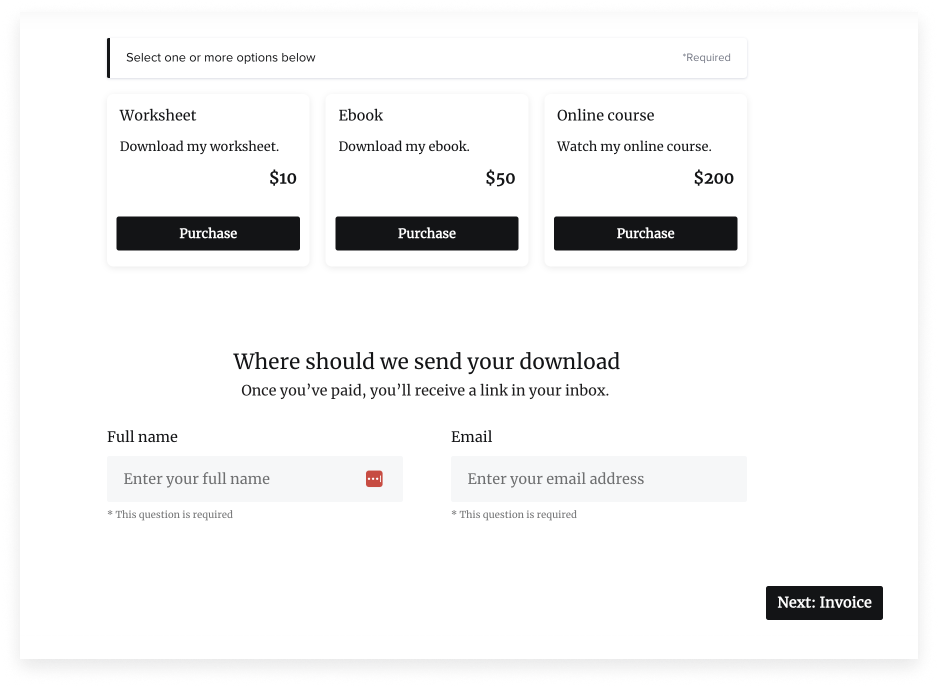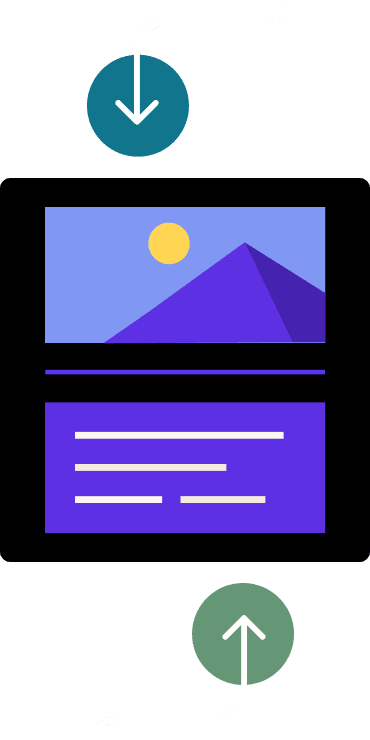Discover the exact process to create digital products that actually sell. Come up with killer digital product ideas, build them with ease, and start generating passive income today.
From online courses to ebooks, most people have purchased some form of digital product. And with the fast-growing digital product market set to reach $74 billion by 2025, there’s never been a better time to create and sell your own.
When done right, digital products offer a low-risk, low-cost, and hugely profitable model to small business owners and service providers looking to scale and increase their income. Instead of trading time for money, a digital product can be made once but sold again and again. It is an attractive opportunity for skilled entrepreneurs to supplement — or even eventually replace — their income.
Sounds great, right? Now, the only question is how to create digital products that actually sell. A fantastic digital service must solve a problem and provide exceptional value to the target client. Then, with the right messaging and marketing, your clients can keep finding and buying your digital offerings with little to no effort from you for each sale.
To build your additional services and start earning passive income, read on to discover how to create phenomenal digital products that sell themselves.
Jump to:
- How to develop ideas for digital products
- Examples of digital products for independent business owners
- How to build digital products
- How to launch and market a digital product
- Get started with digital products today
How to develop ideas for digital products
The idea-forming phase is arguably the most important when creating a digital product. It is vital you create something of real value that people actually need. There are a couple of great ways to approach this. It may take some time, but don’t rush this stage or your product won’t sell.
Ask the market
Instead of creating the service you want and then convincing others to buy it, choose a target market, discover their actual burning problem, and create a digital solution. That way, whatever you create will be an automatic buy for your audience — and you won’t have wasted time creating something people don’t want.
How do you learn the burning problems of your target market?
- Find where your target market hangs out, whether it’s Facebook groups, LinkedIn, forums, Instagram, reddit, or somewhere else.
- Head to groups or comments sections and search for posts where people are asking for help or advice — this is where you can uncover their problems.
- Reach out and speak to real people and ask them their major complaints.
- Write down the most common problems and use these to create your offer.
Pro tip
When doing your research, note down the exact words people use to describe their problems. You can use this later to craft compelling messaging.
Teach your own transformation
Another great way to create a digital product of value that will resonate is to teach how to achieve a transformation you’ve already accomplished. If you try to teach something you haven’t experienced, you may struggle to build trust and authority.
Did you go from being a copywriter to owning an agency? Perhaps you can create a course or resource. Did you create your own website templates because you didn’t like the pre-made ones out there? Perhaps you can teach others to do the same, or sell your own templates. Did you learn how to create group coaching packages and increase your income? Teach other coaches to reach the same level.
If you already have an audience on social media, use Instagram stories, polls, or other community outreach to gather real data and verify your idea.
Examples of digital products for independent business owners
There are many possibilities for digital products that are perfect for independent business owners to increase their revenue.
Checklists, lists, and PDFs
Simple but effective. Downloadables like checklists, lists, and PDFs are simple to create but can provide huge value to your audience.
Depending on your industry, the options are endless. For example, what about a healthy-eating checklist for grocery shopping? A list of all the places you can find online remote jobs? Or perhaps a PDF detailing different types of email marketing sequences?
Although typically some of the lowest value digital products, you can create lists and checklists about almost anything. It is very easy to get started with these and they are usually free to create. They also make great lead magnets to grow your email list.
Ebooks
Ebooks are a great way to offer short, informational texts that provide or collate valuable information. You can create an ebook as a downloadable PDF, so no physical printing is involved.
They can be about anything — the more specific, the better. Some examples could involve a freelancer guide to email outreach, a holistic travel guide to Thailand, a report on AI in the restaurant industry, or any topic that you are knowledgeable about that will help or interest your audience.
Tutorials
If you have a skill, why not teach it to others? Tutorials are a fantastic way to generate passive income in addition to your work with clients.
Tutorials typically come in the form of video classes or long-form articles. You may choose to sell a one-off workshop or masterclass for a fee, create a mini-course with a series of tutorials, or create a blog filled with free resources that you can monetize through ads or affiliate links.
You could even create a Patreon account, where you can upload new content each week or month that people can access for a monthly fee.
Digital courses
The online course market will be worth an estimated $25.33 billion by 2025. Creating an online course can be a hugely profitable way for independent businesses to scale. Consider the areas where you have expertise and how you could teach this to others. Courses typically combine video classes, downloadable resources, and written content.
It is wise to follow the “sell before you create” model to not waste time creating an online product that no one buys. You can launch your course to your audience and have one cohort go through the program live, where you record the content each week. Not only will you get live feedback so you can adapt the content as you go, but this content will become the foundation of your course that you can sell repeatedly.
To create a digital course, you will need:
- A high-quality camera
- A lighting ring
- Editing software
- A neutral space to film
- Course content and scripts
Downloadable templates
Customizable templates are a smart resource that can help people save time and get more professional results.
Templates can be used for anything from design to marketing. For example, a graphic designer could create resume templates, website templates, or templates for graphics. A copywriter or marketing expert could create email marketing templates, website copy templates, or Instagram caption templates. Users can personalize these with their own details.
Take a look at the services you provide to clients and ask yourself if there are any processes or systems you can make a template from.
Licensed content and content libraries
If you produce creative content like photos or music, you may be able to license these and sell them online.
You could sell your photos as unique stock images or create downloadable music for people to add to their multimedia content. You could also try recording audiobooks.
Why not even create your own library and keep adding to the collection?
Memberships
If you are an independent business owner who wants to impact more people with your services, you could create a membership. This model typically works with a monthly subscription where people can access content on a platform.
The type of content you can share with members includes:
- Masterclasses
- Group coaching sessions
- Live Q&As
- Resources, templates, downloadables
- Pre-recorded digital content
- Access to a community of like-minded people
To set up a membership, you will need to pay for a hosting platform to keep all your content. You may need to offer varying and live elements and keep adding new content so members do not cancel.
How to build digital products
Building digital products successfully takes initial research to first determine what would be the best for your target audience. From there, you can select the product that would work best for both your clients and your skillset, then build the product using the right tools.
Conduct market research
The first step to building a successful digital product is market research. You must understand customers’ most urgent problems and find a way to resolve them with your service. Research existing solutions and think about how to improve them.
Market research can involve:
- Conducting interviews with target individuals
- Surveys
- Searching forums and online groups
- Research into competitor products
Decide on your digital product type
Now you should choose which type of digital product will best suit you and your audience. If you don’t like getting behind the camera, you might choose a downloadable product. If you like engaging with an audience in person, you might consider a membership. Think about the way your target clients prefer to learn, too.
Validate your idea
Idea validation is important to ensure your product will be desirable and make changes if not. There are several ways you could do this, including:
- Asking your social media following for feedback
- Send your product to some test subjects for free in exchange for their review
- Test a landing page with a sign up call to action and measure the registrations of interest
Build the product using the right tools
Once you have validated the best digital product ideas, choose the right tools and start creating.
- Downloadable products — You can create these using professional tools like Adobe Suite or the user-friendly Canva and simply save them as a PDF.
- Ebooks — Make sure to include plenty of subheadings to make your ebook easy to navigate and consume. Software or tools like Canva, Adobe In-design, and Visme are great for publishing.
- Tutorials — You will need a camera and editing software, like Wevideo or Final Cut Pro, to create video tutorials. Try subscribing to a video platform like Snagit, Camtasia, or iSpringSuite to host and hold your videos.
- Courses — Plan your content into sections and modules, then record it and store it on a course platform like Kajabi, Udemy, or Podia. Create any additional resources and decide where to set up your community — for example, creating a Facebook group.
How to launch and market a digital product
Now that you have your product, marketing is key in order to get it out there and actually sell.
Work on your messaging
Messaging refers to the words that you will use to sell your product. The most impactful messaging appeals to emotions and desires and resolves deep frustrations. Get specific here and base your messaging on real data collected from your market research.
Here’s where we want to focus on:
- Transformation: What deep problem are you solving? How are you taking your client away from pain and into ease, pleasure, simplicity, etc?
- Benefits over features — Don’t just list out features, e.g. “includes 30 email templates.” Instead, focus on how it improves their life, e.g. “Saves hours agonizing about what to write in your sales emails every week.”
- Go deep — You’re saving your buyer time, but what can that mean? Are you actually giving your customer back time with their kids, time to create a new business, or self-care time?
Decide where to sell your products
You might add products to your website, but the easiest way is to use a ready-built platform. Because there are so many different kinds of digital content to offer, listing them all in separate places makes extra work for you. Streamline your client work and digital products in one place with HoneyBook’s digital product feature, which will save you time and make managing your business easier.
Create a funnel
The next step is creating a sales funnel, the step-by-step trajectory a buyer will take from becoming aware of your product to purchasing it.
Here are a few ways your funnel might look:
- Post about your product on stories → Viewer clicks link to a landing page → They add to cart and purchase
- Someone downloads your free PDF → They join your email list → You send them a sales sequence for your course → They buy the course
- Run a Facebook ad → Link takes them to a landing page → They purchase the product
Get started with digital products today
Don’t delay — the digital product market is still young. There’s never been a better time to expand your business through digital products, and with HoneyBook’s help, you can explore this new arena effortlessly.




